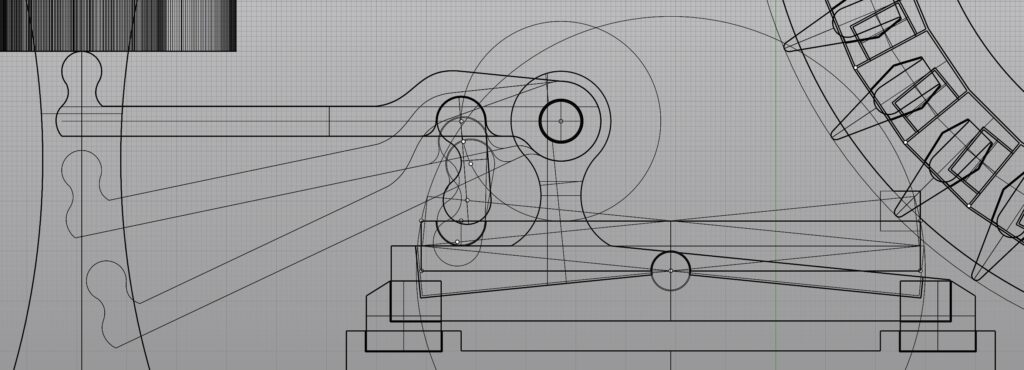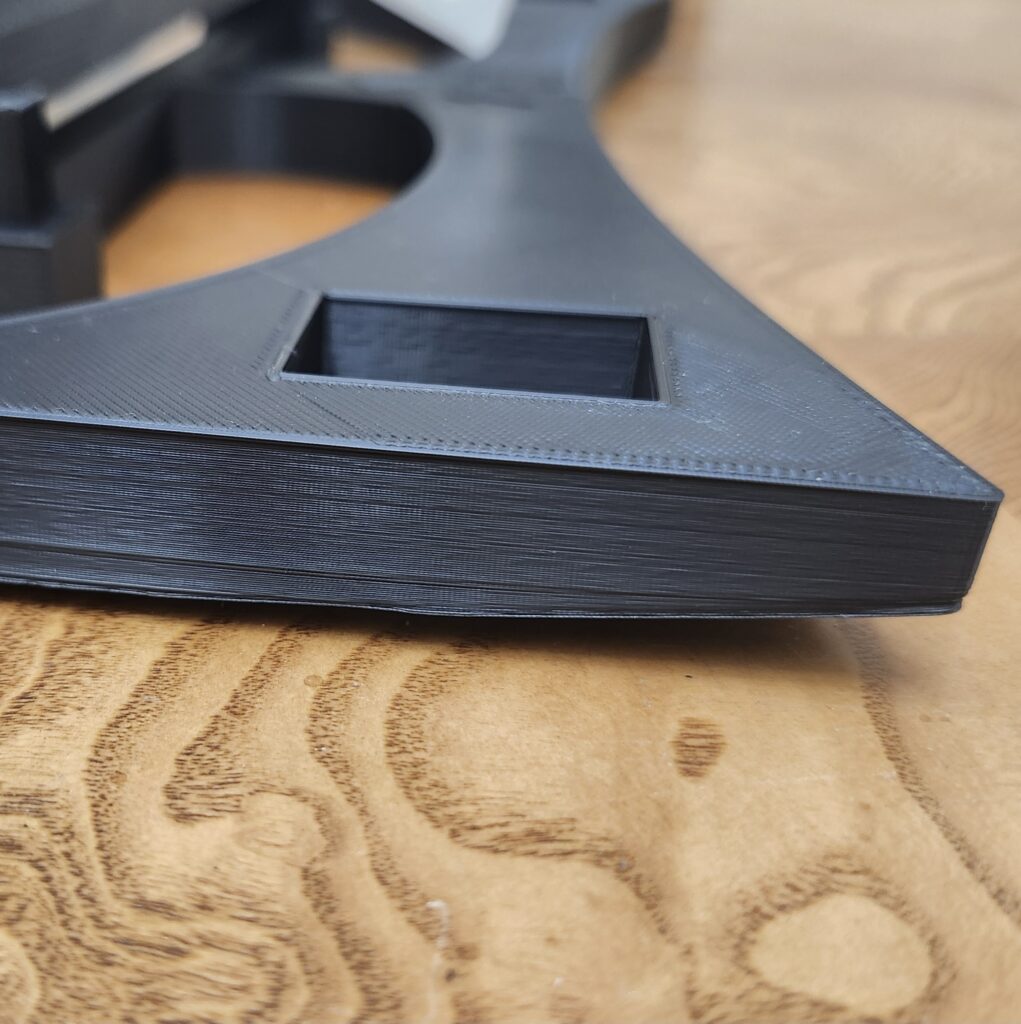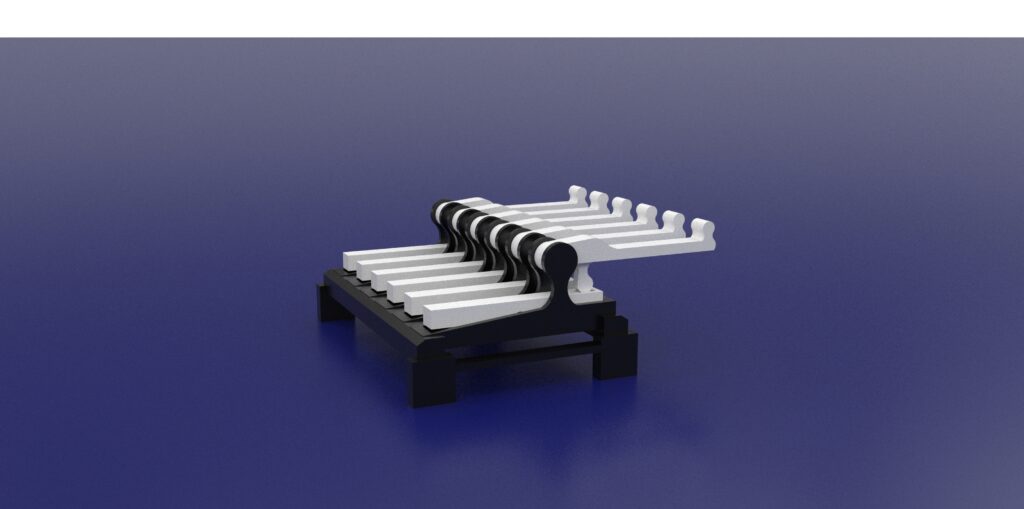
Introduction
I’ve always found simple machines fascinating – watching and playing with gears and levers is so much fun! Because of this, and my love of music, I’ve always wanted to build a music box. In this class, after completing several of the assignments, I found myself enjoying the sounds that were made when I tapped on my vessels, and I decided to make a drum machine that made some similar sounds. I designed the machine, partially by drawing sketches and partially by “sketching” with lines in Rhino, and printed all the pieces to build it. I used Grasshopper to make two of the drums, and I manually modeled the rest in Rhino. The machine doesn’t use glue and can be disassembled. The current version of the machine only has four hammers that actually hit something, with two remaining that could be used for something else.
Background Research
Because I’ve previously been interested in music-box-like machines, I had already watched many videos about the creation of various similar projects (stuff like Wintergatan’s marble machine). These are some specific resources I used for this project:
- I Made a Programmable Music Box https://www.youtube.com/watch?v=E-KkV7kXjwM (for inspiration and ideas about how to design the programmable cylinder)
- Robot Fisherman plays 3D printed mini marimba: https://www.youtube.com/watch?v=cfDg2nb0d1g&t=226s (for inspiration about possible percussive instrument types)
- Printing Mozart’s Piano https://peer.asee.org/25954.pdf (for ideas about lever mechanisms inspired by the piano key mechanism)
- Steinway & Sons Grand Piano Action Model https://sketchfab.com/3d-models/steinway-sons-grand-piano-action-model-a1637020eeea4033a5ec611b50cbf045 (I looked at this for further reference about the lever mechanism, and ended up designing my own mechanism)
- 3D-Printed Musical Instruments: Lessons Learned from Five Case Studies https://journals.sagepub.com/doi/full/10.1177/20592043231210653 (for bigger-picture thoughts about acoustic instrument design with 3D printing, or any fabrication method other than the traditional)
- Musical Instrument Design: Practical Information for Instrument Making by Bart Hopkin (I own this book, and used it for ideas about the design of the percussive bodies)
Process / Outcomes
First I created the programmable cylinder with the removable pieces. To make sure the pieces would work properly, I did two test prints. The piece with the more narrow walls ended up snapping into place more easily.


The pieces around the cylinder and the large caps on the ends have 0.4 mm margins between each edge where they are connected (I tried some of the white pieces with 0.2, and they broke slightly when I put them together. Thankfully, the large caps worked on first try). The whole cylinder took about 148 hours total to print.




For the lever mechanisms, I spent a long time “drawing” with circles and polylines in Rhino to make sure there wouldn’t be unwanted collisions. Where pieces are supposed to move, they have 0.4 mm margins. Everywhere else, they have 0.2 mm margins.
Close to the end of designing and printing the level mechanism pieces, I was running out of time, so I started designing smaller pieces and printing pieces with less infill. This led to a number of imperfect prints (bowed corners), but thankfully they were all basically functional and I didn’t have to reprint any (because at that point I didn’t have enough time). I only had to whittle a little away from some of the unintentionally curved parts to reduce friction in some places.




I’m sad I didn’t get a chance to try more percussive body designs. I wanted to try a tongue drum type, a wood block type, and some kind of jagged or textured surface to scrape across, but I ended up with two basic hollow drum bodies and a shaker – a drum with loose pieces in it. The pieces in the shaker are tree supports from earlier prints (I held onto them because I thought they might come in handy) that I put into the drum while it was printing. Because the two hollow drums were similar, I designed them parametrically in Grasshopper as solid shapes, and sliced them with 10% lightning infill in Cura to make them hollow. I thought the best side to hit would be the bottom (because it isn’t touched by any infill). Hitting the bottom was a deeper sound, but hitting the top was more resonant, because it was more rigid, so I went with that.
I knew I couldn’t finish six percussion instruments in time, so I made three and used one twice (one hammer hits the center of the big drum, and one hits the edge for a different sound). The remaining two hammers do nothing for now, but I can add more instruments later.


Future Work
First of all, I would reprint all the pieces with more infill and at higher quality. I originally wanted to add some artistic designs to the surfaces too, which I would do if I reprinted the pieces at higher quality.
As mentioned above, I want to try more instrument designs (wood block, tongue drum, marimba, wood scraper block, wood frog, etc) and find which ones sound the best. I would also like to experiment with adding resonating chambers to the instruments to change/amplify the sound. I also want to look into adding felt to the lever mechanisms to make them less loud.
I might connect it to a motor so it can play automatically while I play some other instrument. Or I could run it through an effects pedal to get really unique sounds out of it!
Lastly, I’ll consider printing another programmable cylinder with different subdivisions so I can make rhythms in different time signatures.
Reflection
I spent more time on the basic structure and mechanisms than I thought I would, but now I have a machine that works and I can trade out pieces to make changes and perfect it! I think I will try to use this drum machine in some recording or performance, but even if I don’t, it will be super fun to mess with it and experiment with different rhythms. It’s a good tool for finding rhythmic inspiration.
Also, if I do much more 3D printing, I’ll want to invest in an even faster printer!
Files
Rhino File:
Grasshopper File:
Presentation File:
https://docs.google.com/presentation/d/1rlY0-BcJ9Ibk8veriTn_ApncEiCvpsoNAClGi_twA18/edit?usp=sharing